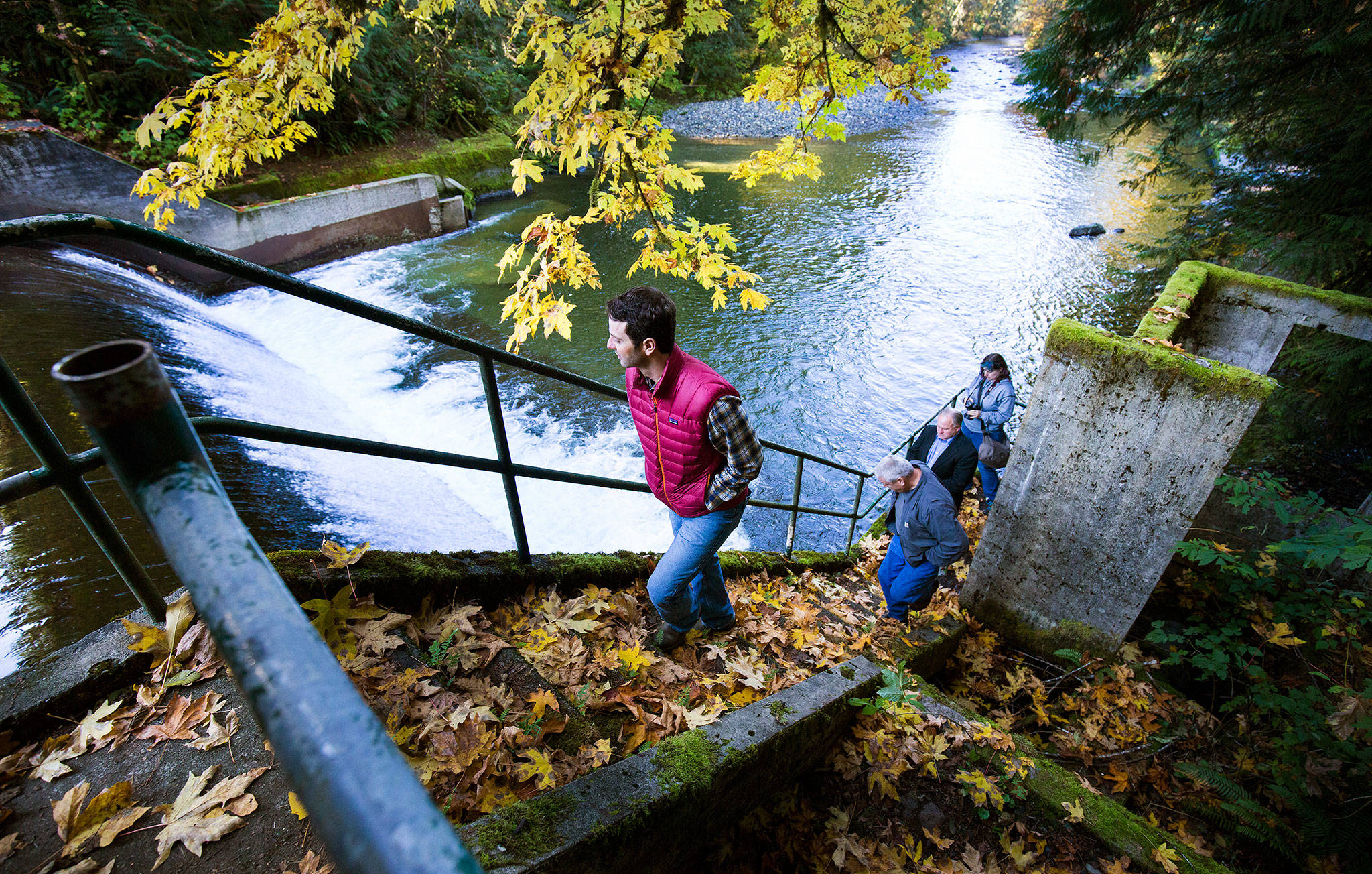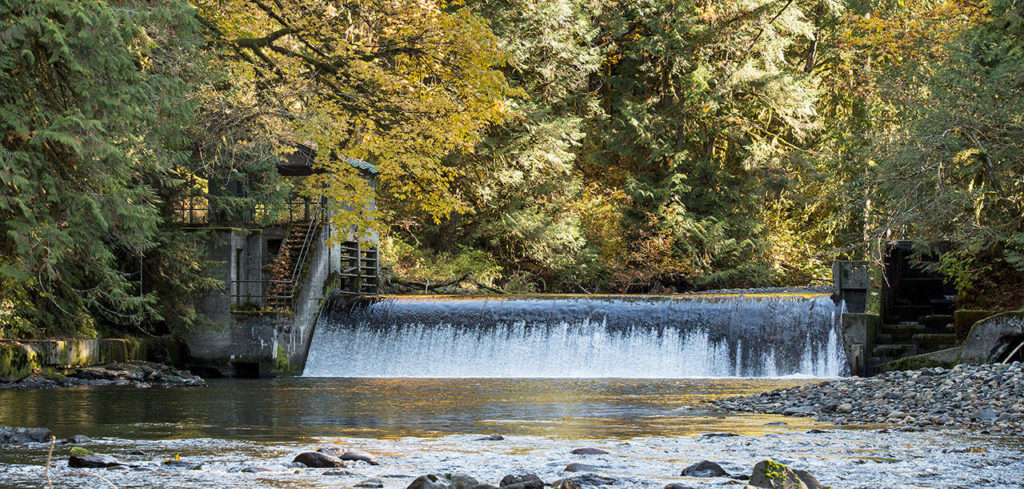GRANITE FALLS — A clear curtain of water falls onto river rock, dropping about the height of a one-story building.
Few people know about this modest dam along the Pilchuck River, a few miles southeast of Granite Falls.
Until early last year, it performed an important function: diverting drinking water for part of Snohomish. Since the city stopped using that water source, the dam no longer serves a practical purpose. Now, it just blocks fish from heading upstream and drains city money.
If a project with the Tulalip Tribes moves forward, this century-old impediment won’t be around much longer. Plans call for demolishing the 60-foot-wide concrete dam by fall of 2020. That would reopen stretches of the Pilchuck and its tributaries to spawning fish, notably to steelhead and salmon species whose populations have dwindled. More fish could benefit Puget Sound’s endangered southern resident orcas.
“The habitat upstream is in pristine condition,” said Brett Shattuck, a restoration ecologist with the tribes. “More than a third of the main stem river length is up here. Everyone is really excited to move this project forward.”
The tribes view it as one of the simpler options for restoring habitat in an area where some fish runs may have plummeted to less than a tenth of historical levels. There’s no reservoir above the dam to complicate the process — and no expected increase in flooding once it’s gone. Over time, the river should even out the drop-off where the dam is now.
“It’s as straightforward as you’re going to get for a dam-removal project,” Shattuck said.
Before any demolition, Shattuck and his colleagues plan to host a series of meetings. They want to talk to landowners along the river and anyone else with questions about the project.
Snohomish leaves the water biz
The current dam and its forerunner have blocked about 14 miles of the upper Pilchuck River since the early 20th century.
The first wooden barrier went up in 1912, a year after a fire destroyed part of downtown Snohomish.
“That caused the city to change its water supply,” said Steve Schuller, Snohomish’s city administrator and utility general manager. “Until 1911, the city’s water supply was in the Pilchuck River, but it was right in town.”
The Pilchuck joins the larger Snohomish River at the city and is considered part of the same basin.
For the dam, Snohomish leaders of yesteryear picked a spot nearly 15 miles away, closer to Granite Falls. It’s unclear exactly why. Best guesses are that it had something to do with the stability of the surrounding bedrock canyon, in an area far from development that had enough elevation for water to flow downhill toward Snohomish.
The concrete dam was built in 1932. The wooden one still exists, submerged a few yards away.
Until being decommissioned in early 2017, the Pilchuck Dam provided water to roughly a third of the people in the city of 10,000, generally in older parts of town south of 10th Street. For decades, neighborhoods to the north have been getting their water from Everett, which is the supplier for about three-quarters of the 805,000 people in Snohomish County.
Snohomish city leaders have pondered their water supply and the dam’s future since about 2009.
“It was the capital costs that really made staying in the water-treatment business not make sense,” Schuller said.
From 2008 through 2012, the city spent $3.4 million on the water-diversion system, for repairs and upgrades, as well as day-to-day operations. The upkeep includes a water-treatment plant built in 1981 up the road from the dam. The city used to employ two full-time workers there.
Yearly operating costs were $381,000, Schuller said, while the city could have bought the same amount of water from Everett for $222,000.
That moved him to reach out to Tulalip.
“I needed their help to be able to get out of the water business,” he said. “Removing a dam on a river is a very complex permitting task. Being a small city, it would have been very hard to even get the permitting started.”
Tulalip also took the lead on grant applications.
The project is expected to cost at least $1.8 million, all told, Shattuck said. Most of the money would come from state grants, with smaller amounts from the federal government, the tribes and the city.
Dam blocks struggling fish runs
In the fall, you can see salmon smacking futilely into the Pilchuck Dam. Some wind up injured. Others die.
There is a fish ladder, but it doesn’t work well. Rushing water clogs it with sediment.
“Fish do get above there, but it is a challenge,” said Jennifer Whitney, a fish biologist with the state Department of Fish & Wildlife.
That’s of particular concern for two types of fish that once thrived here: steelhead and chinook salmon. Both are listed as threatened under the Endangered Species Act. Coho salmon, a species of concern, also stand to benefit from the dam removal.
The river is home to most other local salmon species, plus bull trout and Pacific lamprey.
“The Pilchuck in general is a very important steelhead river,” Whitney said. “There’s a demographically independent population of winter steelhead.”
The Pilchuck hosts nearly a third of all steelhead runs estimated in the Snohomish River system.
Over a decade, starting in 2008, Fish & Wildlife counted a yearly average of 691 steelhead spawning in the river. Numbers above the dam varied, but generally made up 10 to 20 percent of the total, Whitney said.
That’s a huge decline from historical numbers.
A federal study figured the river has a natural capacity for 5,000 to 10,000 steelhead. In 1952 — 40 years after the first dam went up — state records showed 1,583 caught. Put another way: Sport fisherman reeled in well over double the current steelhead population. And that’s only what people reported.
“Unfortunately, that’s the trend across the entire basin,” the tribes’ Shattuck said.
For chinook salmon, which prefer larger rivers, the Pilchuck hosts a smaller proportion for the Snohomish basin as a whole. Chinook counts on the Pilchuck averaged 165 from 2008 to 2017, according to state Fish & Wildlife figures, or less than 4 percent of the total.
Fish & Wildlife doesn’t break out coho counts for the Pilchuck, Whitney said.
The dam removal should help fish, but that’s just one of many problems they face.
“It’s not the only thing that’s stopping their recovery, but it’s a great improvement for fish access to the upper Pilchuck,” Whitney said. “It’s beautiful habitat, especially for steelhead and coho.”
Other threats to fish include development in the watershed and the polluted runoff that comes with it. Rising temperatures and shrinking snowpack aren’t helping either. The loss of marine habitat, ocean acidification and plastic waste hamper survival at sea.
One bit of good news: 2017 saw the largest number of young chinook traveling down the Snoqualmie River toward Puget Sound since counting began in 2002, according to data from the Tulalip Tribes. The numbers remain far short of recovery targets, though.
In the hopes of turning the tide, Snohomish County, the Tulalip Tribes and other governments are spending tens of millions of dollars to restore marshes at the mouth of the Snohomish River between Everett and Marysville by removing old dikes.
Many dams are coming down
When it comes time for demolishing the Pilchuck Dam, crews are likely to use a large, jack-hammer-like tool at the end of an excavator, Shattuck said.
“We’re going to be doing it in stages to prevent water-quality damage as well as any potential risk to adjacent landowners,” he said.
It’s hardly the only dam that’s come down lately. The largest and best known freed up the Elwha River between the Olympic Mountains and the Strait of Juan de Fuca. It took an act of Congress and years of preparation to carry out the demolition of two hydroelectric dams on the Elwha, starting in 2011. Fish have been recolonizing areas miles upstream from the former dams. While encouraged, scientists say it will take time to gauge how that affects spawning populations.
Close to 1,500 dams have been removed from American rivers over the past century, most of them in the last 30 years, said Julian Olden, a professor at the University of Washington’s School of Aquatic and Fishery Sciences.
“In fact, 2017 was a damn good year for dam removal, where an estimated 86 dams were removed across the United States,” Olden said. Removal of the Pilchuck Dam will add to the growing majority of removals of dams less than 25 feet in height.
Local and regional examples include a dam breached on a Sauk River tributary near Darrington in 1985 and the Goldsborough Dam taken down near Shelton in 2001.
Decisions to decommission dams tend to be complex, the professor said, just like building them in the first place. It requires weighing ecological benefits and drawbacks against doing nothing. It’s worthwhile, in his view, to continue reviewing obsolete dams of all sizes as candidates for deconstruction.
Olden called removing the Pilchuck Dam to improve fish habitat “undoubtedly a good thing.”
Snohomish may be leaving the water business, but the city wants to keep its options open. Schuller, the city administrator, said he’s working with the state Department of Ecology to put Snohomish’s water rights in a trust. That could help decades later, should the need arise to tap its own water supply once again.
Noah Haglund: 425-339-3465; nhaglund@heraldnet.com. Twitter: @NWhaglund.
Talk to us
> Give us your news tips.
> Send us a letter to the editor.
> More Herald contact information.


























